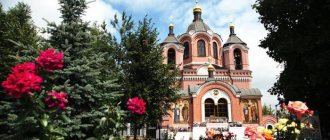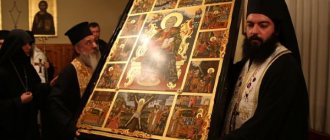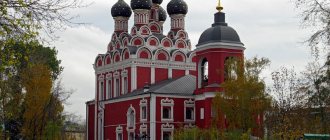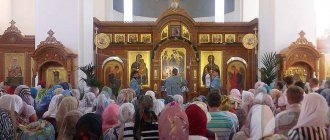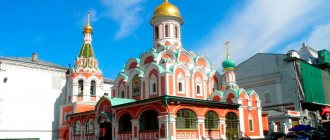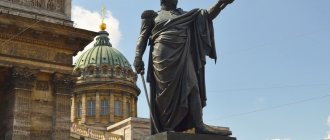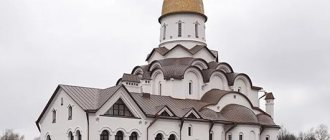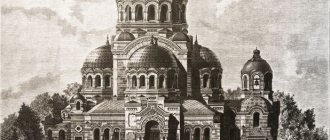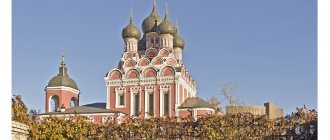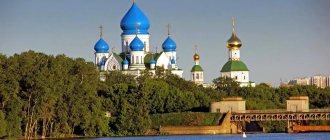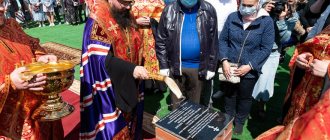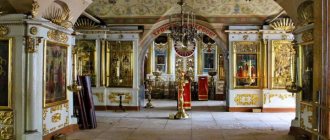Chapel of the Iveron Icon of the Mother of God
| Photo from the site hram.codis.ru |
The Iveron Icon of the Mother of God in the chapel at the Resurrection Gate has been and remains the most revered Moscow shrine since the 17th century.
There is a legend that during the iconoclast persecutions in Byzantium under Emperor Theophilus in 726, one of the iconoclast warriors named Barbarian hit this icon on the right cheek with a spear, and blood immediately flowed out of it. The bleeding wound remained on the face of the Mother of God - that is why the Iveron Mother of God is always depicted with a small wound on her face. Since then, the icon began to be revered as miraculous.
According to legend, in the 9th century this icon of the Mother of God was in the house of a pious widow who lived near the city of Nicaea. Imperial spies came to her and offered her to pay off or give them the icon for destruction. The widow asked the soldiers to wait until the morning to collect the required money, and when they left, she took the icon to the sea and lowered it into the sea with prayer, realizing that it was impossible to pay off. And then a miracle happened - the icon did not drown, but stood on its edge and rushed along the waves. The widow's son escaped persecution to Mount Athos, where he became a monk at the Iveron Monastery. He told the monks about the miraculous icon that was in their house and how it escaped from the iconoclasts.
This story became the sacred tradition of the monastery. Almost two hundred years later, the Athonite monks saw a pillar of fire in the sea, which rose above the icon of the Mother of God. At night, the monk of the Iveron Monastery, Elder Gabriel, saw the Mother of God in a dream, who told him to walk on the water and take the icon to the monastery. For three days and three nights the brethren prayed before the miraculously appeared icon, and then they placed it in the cathedral church, but in the morning they discovered the icon on the wall, above the monastery gate. Several times the icon was transferred back to the church, and each time it returned to the gate. Again, Elder Gabriel in a dream recognized the will of the Mother of God: “I do not want to be protected by you, but I want to be your Guardian not only in this life, but also in the future...” Then the monks built a gate temple in the name of the Mother of God and placed a miraculous image in it, which began to be called the Iveron Icon of the Mother of God of Portatissa (in Greek - “Goalkeeper”).
The Iveron Icon became famous for many miracles: it protected the monastery from enemies, the sick were healed around it, and through the prayers of the monks in front of it, the monastery’s granary was filled with flour in lean years...
| Iveron Icon of the Mother of God |
In the 17th century, they learned about the miraculous icon in Rus'.
At the beginning of the reign of Alexei Mikhailovich, Archimandrite Pachomius of the Athos Iveron Monastery came to Moscow to collect donations in favor of his monastery. The tsar's closest friend, Archimandrite Nikon of the Moscow Novospassky Monastery, the future famous patriarch, asked him to send to Moscow an exact copy (as a copy of the icons was called) from the miraculous Iveron Icon. A legend has been preserved that the Tsar and Nikon wanted to receive a real icon and asked to send them the original Iveron Image of the Mother of God from the gate church. But the monks did not dare to violate the will of the Most Holy Theotokos and give away the miraculous shrine from the monastery, where she herself appeared and where she wished to stay. Then the icon painter of the Iveron Monastery, Iamblichus Romanov, completed a copy of the Iveron Icon, which did not differ in a single detail from the original. The paints for it were mixed with holy water, which had previously been poured over a cypress wood board intended for painting the icon.
On October 13, 1648, the icon was solemnly greeted at the Mother See at the Neglinen Gate of Kitay-Gorod and temporarily placed in the St. Nicholas Monastery. After some time, the Iveron Icon was sent to the Valdai Monastery, and for Moscow the Iveron Monastery was ordered to make another copy of the icon.
He arrived in Moscow on May 19, 1669, and was placed on the Neglinen Tower. To protect the icon and praying people from wind and rain, a small wooden canopy was erected over it. This is how the Iverskaya Chapel appeared in Moscow. The location was not chosen by chance: the Neglinensky Gate was the main gate of Kitai-Gorod, and through them, according to tradition, the ceremonial entries of the Russian Tsars to Red Square took place. Therefore, the gate had another name - Triumphal. They were also called Chicken Houses - after one of the shopping arcades nearby, where chickens were sold, and Lion Houses, because nearby was the Lion Courtyard, where the lions given to Ivan the Terrible by the English Queen Mary Tudor were kept.
It was from this place that in 1534 they began to build the fortress wall of Kitay-Gorod, which at first had no passage gates at all in this area, but was adapted only for battle: here, above the blank wall, there were loopholes and drains for tar and boiling water. We drove to the Kremlin from this side through the Trinity and Borovitsky gates. Then the wall was broken through for a drive-through gate. Over their more than hundred-year history, they became so dilapidated and damaged, especially during the Time of Troubles, that in 1680 Tsar Fyodor Alekseevich began to rebuild them. Two tall elegant tents, crowned with double-headed eagles, appeared above them, and an icon of the Resurrection of Christ was placed on the wall of the gate, which is why they began to be called Resurrection. In addition to her, by order of the sovereign, the following were depicted on the gate with a “good letter”: Rev. Sergius, Great Martyr George the Victorious, warrior St. Theodore Stratilates and Moscow saints Peter and Alexei. They were given the protection of Moscow and its newly built “city” - China. It was a Russian tradition: the gates - the entrance and exit from the city - were shaded at the top with icons.
It is known that under Anna Ioannovna, the Mint’s assay laboratory was located in the chambers located in the room at the top of the gate. Here, under Empress Elizabeth, there was the first civilian printing house, and in April 1756 even began printing the newspaper of Moscow University, which was opened opposite the year before.
The Synodal Decree of 1722 destroyed almost all the chapels in Moscow, but did not touch Iverskaya. Under Elizaveta Petrovna, it was decided to dismantle it as dilapidated - in the documents its room was called a “wooden closet” with the icon, but the abbot of the Nikolo-Perervinsky monastery, to which the chapel was assigned, asked to rebuild it and a stone “attachment” was erected above the icon.
The Iverskaya Chapel received its final (and modern) appearance in 1791, when it was rebuilt by Matvey Kazakov, and at the beginning of the 19th century, through the works of the artist Gonzago, the chapel was “splendidly decorated”: the outside is covered with tin, decorated with copper pilasters with capitals, garlands and eight-pointed stars. A gilded figure of an angel with a cross was installed at the top. The pre-revolutionary chapel could accommodate no more than fifty people.
Muscovites have always loved their chapel very much, and no one began their business without praying before the miraculous image. It was called “a joyful crossroads for all believers.” The blessed power of the Moscow Goalkeeper was so great that not only Muscovites and not only Orthodox Christians revered her: Catholics, Lutherans, sectarians and even non-church people came to bow to the famous miraculous image - faith and hope for help were stronger than human convictions. Merchants came here before a trade deal, students and high school students came here before exams. The Iveron Icon became famous for healing the sick.
Often the Iveron Icon was taken in special carriages to the homes of Muscovites who asked to serve a prayer service at the bedsides of the sick or simply under their own roof. To prevent the chapel from being empty, an exact copy of the icon was made, which replaced it during absence. There is a version that it was the list that was transferred after the revolution to the Church of the Resurrection in Sokolniki, although many old-timers and eyewitnesses confirm the news that the original itself is in the said church.
Everyone who came to Moscow, first of all, went to bow to Iverskaya. The founder of St. Petersburg himself, Peter I, a Muscovite by birth, incurred the enmity of the townspeople by the fact that, having returned in 1699 from his first trip to Europe, he did not go to Iverskaya, as the kings did before him, but immediately galloped to Lefortovo to his beloved Anna Mons. However, in 1721, Peter the Great solemnly entered Moscow through the Resurrection Gate after winning the Northern War and concluding the Peace of Nystadt.
The triumphal procession consisted of “a whole flotilla arranged like a real one, with sails outstretched, with the bells ringing throughout Moscow and the thunder of cannons.” Peter defeated the Swedes - his teachers, who once minted a medal for the victory over the Russians near Narva!
Then the Tsar stopped at the Iverskaya Chapel, where he was greeted with honor by the Moscow clergy, senators and military men, who gave him welcoming speeches, and young men in white robes sang cantatas.
One night, the sovereign was riding in a covered sleigh past the Resurrection Gate, and towards him was a boyar's sob harnessed to six horses, which overturned the deacon's sledge. Instead of helping, the boyar servants began to beat the deacon and did not recognize the king who stood up for him. “Who else is riding in a box!” - they snapped. Enraged Peter beat the boyar's coachman and postilion with a stick and ordered his orderly to raise the clerk's overturned sledge. And in the morning he blasted the boyar himself “for pandering to slaves.”
Since the time of Peter, all imperial persons who arrived in Moscow, including for the coronation, from the new northern capital, first of all, came to bow to the Moscow shrine and always said goodbye to it when returning to St. Petersburg.
And at the Resurrection Gate, Emelyan Pugachev was in prison for two months in chains. Crowds of people gathered to look at him. When the robber shook the shackles, there was a terrible ringing and the women fainted from fear.
There is a legend that before leaving for execution, on Bolotnaya Square in Zamoskvorechye, Pugachev prayed at the Iverskaya Chapel and bowed to four sides with the words: “I am guilty before God and the Empress. Forgive me, Orthodox Christians!” From the crowd they answered him then: “God is your judge, villain, you killed, ruined my father, brother...” (According to another version, this happened on Bolotnaya Square itself, already before the execution.)
Iverskaya left Moscow only once - in September 1812, when the Right Reverend Augustine took her out of the city to Vladimir along with the Vladimir Icon (the list was hidden by the monks of the Nikolo-Perervinsky Monastery) where the shrines stayed for two months and in November 1812 they returned unharmed to Moscow. In memory of the expulsion of Napoleon, a religious procession was held annually in pre-revolutionary Moscow: a procession from the Kremlin headed to the chapel, the Iveron Icon was taken into their arms and reverently carried around the Kremlin walls.
The great Muscovite Marina Tsvetaeva wrote about this icon with special warmth and faith, calling it the heart of Moscow:
And behind that door, where the people are flocking, there the Iberian heart, Red, burns. And “Hallelujah” pours onto the dark fields. I kiss your chest, Moscow land.
After the revolution, the Iverskaya Chapel was brutally abused. On Christmas Eve 1923, a blasphemous event called “Komsomol Christmas” was held in Moscow. Its main action took place on the square in front of the Iveron Chapel. And the task of this event was to educate young people with the “correct” worldview and appropriate morality.
A huge crowd staged something like “Komsomol Christmastide” with mummers, only they dressed up mainly as Orthodox priests and monks, presenting them in the ugliest form. The terrible night procession set off from Petrovka along Bolshaya Dmitrovka to Sadovaya, and from there along Tverskaya to Revolution Square, where the main action of the “holiday” unfolded. In front were posters with obscene inscriptions, stuffed animals of the gods of ancient Eastern and world religions - Osiris, Marduk, Allah, Buddha, and blasphemous images of the God of Hosts, Christ and the Virgin Mary. The God-fighters did not abandon other religions either: there were rabbis, Protestant pastors, the Pope, and the Chinese bonze. In Andrei Shokhin (so called in the newspapers) loudly sang an “akathist to Marx” with exclamations of “Rejoice, O Marx, great miracle worker!” A grandiose bonfire was built in front of the Iverskaya Chapel, in which all religious “paraphernalia” was burned while the “Komsomol choir” sang:
Let's pull all the gods to the ground! Squeal, devils, have fun! Let's dance Carmagnola! All gods to the carnival! The godless Komsomol is rowdy in the highest grove!
And the morning newspapers invited us to have more fun at the “Komsomol Easter” in the spring, reminding us to take more whistles and pipes with us: “knock out the thousand-year-old foolishness, so with a bang!”
The Iveron Chapel soon disappeared: it was demolished, and the icon was transferred to the Church of the Resurrection in Sokolniki. In 1929, an ugly sculpture of a worker, the new socialist “goalkeeper,” was temporarily installed on the site of the chapel. In his right hand he menacingly clutched the lowered hammer, and with his left he threw it up in a vertical salute.
In 1931, the Resurrection Gate was also demolished to make way for demonstrations and automobile traffic.
In the early 90s of the last century, a copy of the original Iveron Icon was again made on Mount Athos. In November 1994, Patriarch Alexy II consecrated the foundation stone of the Iveron Chapel and the Resurrection Gate. In less than a year, they were restored by decision of the Moscow government according to the design of Oleg Zhurin. On October 25, 1995, the chapel was reopened.
In Moscow there is also a parish church of the Iveron Mother of God on Bolshaya Ordynka. Built before the Romanovs, it was first consecrated in honor of the Great Martyr George the Victorious, and then the chapel of the Iveron Icon appeared.
In 1798-1802 During the reconstruction of the church, a temple with a main altar was built in honor of the Iveron Icon, and the former Iveron chapel became St. George's. It is known that the architect at that time was the famous master of Moscow classicism I.V. Egotov, who built a new building of the Lefortovo military hospital in the city.
During Soviet times, the church was closed and dilapidated. It alternately housed a factory club and an art gallery. And in 1992 the church was returned to believers.
How to get there
There are several ways to get to the temple, each of which has its own characteristics:
| Way | Description | Time (excluding the time spent on the path to the starting point). | |
| By car |
| 4 min. | |
| By public transport | Bus |
| 11 min. |
| Metro |
| 7 min. | |
It is necessary to choose a route taking into account the location of the parishioner. If time is limited, then in the absence of personal transport you can call a taxi.
Architectural features of the temple
To get to the Church of the Three-Handed One, you need to go through the gates of the Patriarchal Compound , which amaze with their beauty and grandeur. A golden dome with a cross rises above the brick wall. On the sides there are two semi-domes, also ending in crosses.
After passing through the gate, you can see the temple itself - a small wooden structure surrounded by an open gallery.
The roof of the temple is a cone, creating a tent-like composition of the structure, which belongs to the type of octagonal building on a quadrangle. The altar apse of the temple has a rectangular shape. Above the western part there is a small belfry, which also takes the form of a tent.
The temple and belfry are crowned with domes with crosses. One dome over the temple symbolizes the unity of the Lord God. On the pediment you can see church images of the icon of the Mother of God, angels rushing towards her, and saints observing this sacrament.
Opening hours and schedule of services
Divine services in the Three-Handed Church are held every day. The doors of the temple do not close all day, which leaves the opportunity for parishioners to come and pray at any time.
The schedule of services can be found below:
| Time | Divine service |
| Weekdays | |
| 17-00 | Vespers. Matins. Confession |
| 7-30 | Watch. Divine Liturgy. Church hymn. Prayer service for the departed. |
| Resurrection | |
| 17-00 | All-night vigil. Confession. |
| 6-00 | Watch. Confession. Early Divine Liturgy. |
| 9-30 | Watch. Confession. Late Divine Liturgy. |
| Holidays | |
| 17-00 | All-night vigil. Confession. |
| 6-30 | Watch. Confession. Early Divine Liturgy. |
| 9-00 | Watch. Confession. Late Divine Liturgy |
Daily life of the temple
The Church of the Three-Handed One in Orekhovo-Borisovo is not only a place for worship, sacraments and services, but is also one of the educational centers of Moscow. Today, the church hosts meetings dedicated to the Orthodox faith, its history and basic principles.
Also at the temple, youth and teenage clubs are organized, at a meeting of which young people can talk about faith, read the Gospel together with the clergy, and better understand the meaning of holy scripture. Club members go hiking, travel to holy lands, take part in charitable activities, and enjoy good films and literature.
Youth club classes start at 11:30.
There is also a Sunday school at the church, which traditionally starts on October 7, but anyone can come to school throughout the entire school year. Sunday school classes are held every Saturday. The schedule of classes can be found on the temple website.
Civic conversations are also held on the territory of the temple. They are classes in which biological parents and godparents are prepared for the sacrament of holy baptism. It is important to know that classes are held only for those who belong to this temple.
The lecture will tell you how to prepare for baptism, what to buy, what prayers to learn.
Temple shrines
- The icon of Lyudmila of Czech with a particle of relics helps to get rid of discord in the family and patronizes all women who bear her name, as well as mothers, grandmothers and those involved in teaching;
- The icon of the blessed Matrona of Moscow with a particle of her relics helps women experience the happiness of motherhood, solve financial difficulties for people, save their families and heal from serious illnesses;
- Cross with earth from the monastery of St. Sava , consecrated, where John of Damascus labored. The saint will help parishioners who venerate the cross to be healed even from such serious diseases as leukemia and oncology;
- Ark with 60 particles of the relics of the holy saints of the Kiev Pechersk Lavra , including St. Ilya Muromsky, Prmch. Anastasy Deacon, Venerable. Domian Tselebnik and others;
- Ark with a particle of the relics of the holy great martyr and healer Panteleimon , who helps to heal from all diseases;
- Ark with a piece of Mamvrian oak , under which Abraham himself received the Holy Trinity.
It is believed that this tree connects a person with God and the Universe.
Interior decoration
The Church of the Three Hands in Orekhovo-Borisovo amazes with its interior decoration. The vestibule and the middle part of the temple are separated by a wooden arch supported by two columns, which, like everything else in the temple, are made of wood. Above the arch is the icon of the Dormition of the Blessed Virgin Mary.
In the center of the composition is the Blessed Virgin on her deathbed. At the head of the table stand the apostles whom Mary wanted to see, and whom the Lord himself sent to her bed. Here you can see John the Theologian, and this seems symbolic if we remember the history of the Sursk monastery. It was he, John, who Christ commanded to take care of the Blessed Virgin.
At the top is Jesus Christ himself in a blue sphere, symbolizing the Kingdom of Heaven.
Light enters the temple through lattice windows of a vertical rectangular shape. It illuminates icons enclosed in carved wooden frames. What you should especially pay attention to is the iconostasis. It is also made of wood and features a stunning carved composition. It was made to order in the Greek city of Thessaloniki.
Perfectly combined with the pulpit and the royal doors, it harmoniously completes the interior decoration of the temple.
Interesting facts about the Three-Handed Church in Orekhovo-Borisov
- The temple stands on holy land, consecrated by John of Kronstadt , as can be learned from the poetic chronicle written by the first pupils of the Sursk monastery.
- The construction of the temple in Orekhovo-Borisovo became the reason for the restoration of the monastery, destroyed with the advent of Soviet power. According to legend, the monastery servants were drowned in the river.
- The first divine liturgy was held in the open air , because... The temple was built on the territory of the former convent later.
- The temple icon of the Mother of God “Three-Handed” was painted by artists Lyudmila and Elena Isaev.
- In May 2010, parishioners began collecting signatures for the government in order to obtain an abandoned plot next to the temple for further improvement and construction of a new temple.
The Church of the Icon of the Mother of God “Three-Handed”, despite its short history, attracts not only parishioners of Orekhovo-Borisovo, but also pilgrims from other countries who want to bow before the shrines of the temple.
Article design: E. Chaikina
